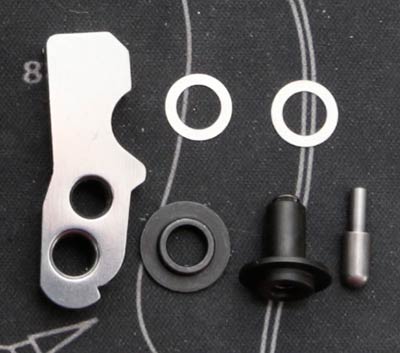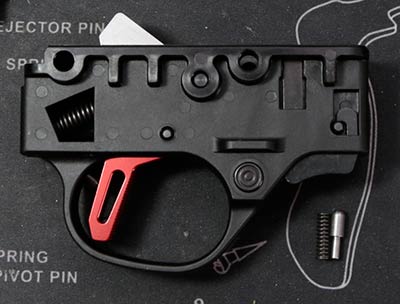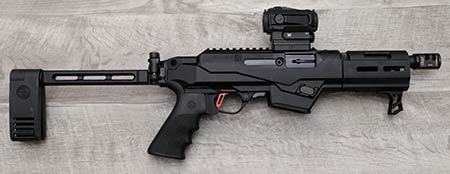When I saw that Volquartsen offered a target hammer for the Ruger PC Carbine and PC Charger, I had a decision to make. Which version of mine to put it in? I’ve got a pair of PC Carbines, and a PC Charger. In the end, my PC Charger won. It’s the one I shoot the most, and while the factory trigger is good, it could be better. In my opinion, whether for fun, competition, or defense, it would benefit from an improved trigger.
A simple, affordable upgrade you can install at home
Volquartsen designed their target hammer to give the factory Ruger PC Carbine and PC Charger the benefits of a trigger job without the extra cost and hassle of having a gunsmith do it. It’s as easy as replacing the factory hammer. No special tools, no stoning, and no fitting needed. In less than 30 minutes, anyone with a basic set of tools can bring their trigger pull down to around 3 – 3.25 pounds.
Its $45 price tag is obviously a big selling point as well. That’s within the budget of most enthusiasts, and certainly less than a gunsmith would charge for a trigger job. Plus, being replacement parts rather than modifying factory parts, it’s reversible too. For those with deeper pockets, Volquartsen also offers a drop-in trigger assembly for these Rugers. The TG9 is a complete unit, priced at $273. Although that’s a bigger chunk of change, you get a trigger with a 2.5 pound pull, adjustable for both pre-travel and over-travel. But that price is also what makes this $45 target hammer more appealing.
What’s in the package
Each kit includes hammer bushings, some shims, and a replacement trigger plunger with spring. As expected, the hammer itself is EDM cut from A-2 tool steel and hardened to Rc 58-60 for reliability and long life.

Installation
Installation was easy. For safety reasons, I always stress making sure the firearm is unloaded. But with the barrel removed, there’s no chamber. So clear it, and remove the front half. Of course, which model you have will dictate how you disassemble it, but they all require two pins get punched out to drop the trigger group. If you’ve been maintaining your Ruger properly, then removal of the trigger group should be a familiar process already.
No instructions were included, but it’s pretty straightforward, thanks to their video found here. Note that the whole video is only three and a half minutes long. Watch it once, and then go back and watch it again if you run into any issues. The only difference between installing the factory hammer vs the Volquartsen target hammer is the bushings. Make sure they are installed in the hammer correctly, then do a test fit. If there is any extra side to side play, use the included shims to remove that. Note that the trigger plunger and spring is designed for the use with the factory trigger, and not compatible with my aftermarket trigger. So I didn’t use them (this was cleared with Volquartsen support), but the hammer functions fine. Before reinstalling, check the trigger for proper function, including the safety.

Results
My factory hammer and sear combo had a pull weight of about four pounds. Over a half dozen test pulls, the Volquartsen target hammer upgrade yielded a pull weight of 3 pounds, 4 ounces, which is exactly as advertised. Also, there’s no grit or creep to it, and it has a nice distinct break. In hindsight, I should have maybe swapped this with my carbine’s trigger, which breaks a bit over five pounds. Still, it’s a nice improvement in overall feel as well as weight. Not nearly as heavy as factory, but not so light as to be a liability. I think 3 to 3.5 pounds is the sweet spot for most triggers.
I haven’t done a comprehensive test with group sizes, for a couple of reasons. The most obvious one is the cost and availability of ammo. Add in the fact that I don’t have any “before” groups to compare it to either. We shoot outdoors at homemade targets, and a gong. As long as I can put all my rounds into the center of our hand-drawn “silhouette” style zombie/bad guy targets, I’m happy. This just makes it that much easier. When I hand it over to my nephews, they have an easier time with it too. A lighter trigger won’t fix bad technique, but it can certainly offer better results when used properly.

Conclusion
Although I’ve only used the Volquartsen target hammer for a couple of boxes of ammo, I wouldn’t hesitate to recommend it to anyone looking to upgrade their PC Carbine or PC Charger. I’m sure that for legal reasons, most manufacturers are hesitant to install lighter triggers on anything but “competition” rated firearms. Ruger’s PC Carbine and PC Charger are both pretty good, if not a little heavy, right out of the box. I’ve upgraded mine with flat-faced triggers, and have been happy enough with them. But the Volquartsen target hammer greatly improves the trigger. And it does so for a reasonable price. The fact that just about anyone can swap it out at home makes this one of the best upgrades available. Plus, it’s not permanent. Should you ever need to send your Ruger in for warranty service, it’s no trouble to swap the factory hammer back in first.
I’d like to thank Volquartsen for providing their target hammer for my testing and evaluation. As always, they’ve come up with an excellent product. Hopefully, I’ll get to compare it side by side to their TG9 trigger group one day. In the meantime, I’m more than happy with this affordable upgrade.